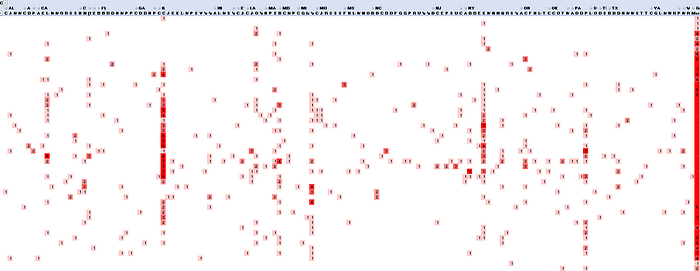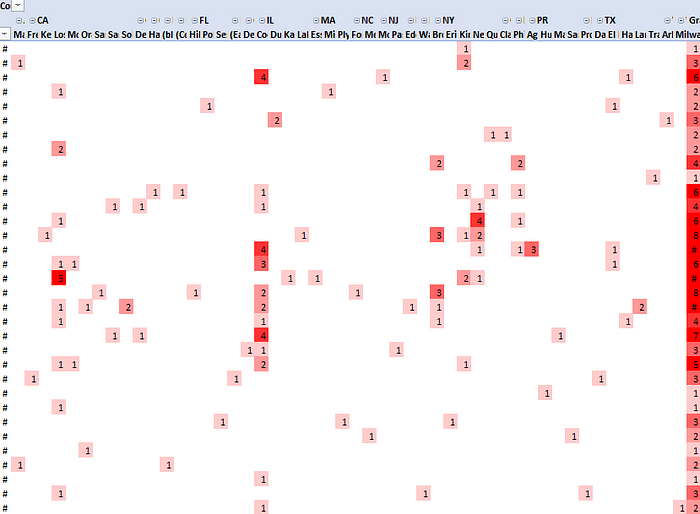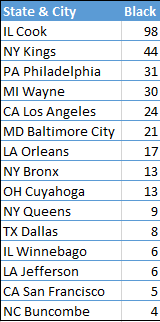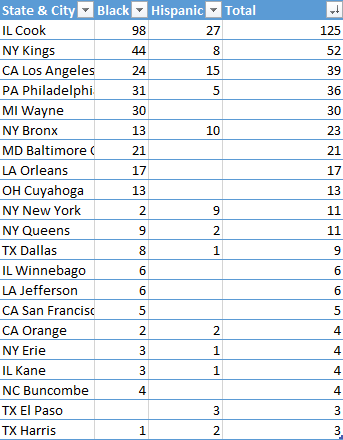Wrongful Convictions In The United States Are Terrible, But It’s Not A Countrywide Systemic Racism issue
You can use the data to tie wrongful convictions back to a handful of counties. The question is — What’s going on there and Why?

Spoiler: I can’t answer that question for you. You’re going to have to do the digging there for yourself. I’m only trying to give you a map and a shovel.
Recently in an argument online, someone brought up the Innocence Project as an example of clear-cut systemic racism in the United States, leading to claims like this:

Black people are 7 times more likely to be wrongfully convicted of murder than white people — The National Registry of Exonerations
The problem is that claims like this is that they aren’t just outrage bait (sorry, but it’s true — it’s a gorgeous soundbite designed to propagate like gossip, created for shock value), but focusing on it overlooks larger problems which can actually be tackled — unlike the spectre of systemic racism. Tackling that is like boxing with a cloud.
Is It Bad Methodology?
The Innocence Project’s 7x figure is arrived at in a way that is simple, but feels like it was the only figure that could squint and generate with the available data, so they went with it — even if it’s not particularly meaningful.
Simply comparing the % of wrongful convictions by race for any given type of crime — which the National Registry of Exonerations does — seems suspect.
At an absolute minimum this is an invalid comparison; what you have to do is look at how many convictions total there are by race, and what percentage of those convictions were wrongful for that race. You can then compare the percentage prevalence of wrongful convictions by race and if they’re not the same to within some margin of error, there’s something worth digging into further. This assumes that convictions are normally fair and just, true. I think we can make that statement — the number of wrongful convictions is very small (<1%) compared to the number of convictions in any given year.
Only looking at the total number of convictions and bucketing them by race (as was done to create the 7x statistic) is not valid as it assumes that there should be a perfectly even distribution of wrongful convictions by race in a fair world. (There’s a hidden implication there: that in a fair world, wrongful convictions would only be due to some kind of unfortunate accident. Their data shows that this is actually quite rare, and usually there’s something kind of foul play or (at minimum) a breach of protocol going on — filter by wrongful convictions classified as “OM” in their data if you want to see how many of those cases that is.
There’s also a few other assumptions that don’t follow from this random distribution = fairness approach. For example, we know that crime follows poverty. We also know that poverty affects African Americans and Hispanics more than White Americans, and this is explained as being due to racial inequities that still resonate in outcomes for people born today — decades after the Civil Rights Act of 1964 — especially because generational wealth hasn’t been acquired. In effect, African Americans are more likely to be starting from scratch with no inheritance, and even worse, this depresses their chances because it makes it more likely that your parents will be in poverty, which affects your nutrition (which affects your health and ability to learn as a child), which affects your opportunities.
It’s like expecting a drowning person to be able to do a great 10 lap race (after all, they’re in the water and they seem to like it so much that they’ve even put some in their lungs for safe keeping)— first you need to help them so that they’re not drowning.
Can We Tie Poverty Rates to Crimes?
For what it’s worth, those poverty numbers — for 2013 and 2014 — look like this (we’ll use the 2014 ones as that matches some of our prison population data):

(Strangely, Native Americans, people of mixed race, and other races are not included in this data set. I have no idea why. And according to the doc, some people marked themselves down with multiple races and are included in the counts for each group, so it’d be hard to tease these apart further).
Here’s what we get when we process those poverty figures a bit:

Those relative weighting numbers on the right compare the likelihood of committing a crime if poverty linearly makes you more likely to commit one, for three different models which might apply. (We relatively weight using White people because they’re both the largest group size, and we’re trying to examine racism against the other races, so we pick that as our “default” case. We could pick any; it’s not important).
If poverty and crime have a nonlinear relationship our prediction here is going to be wrong. But assuming it’s at least vaguely linear, we have three ways we can look at this data:
- If in-group poverty rates are more important for crime, black people are more likely to commit crime than white people at a rate of 2.6x.
- If the rate of poverty vs. the total population is important, we should see crimes black people committing crimes 0.55x as often as white people.
- I don’t believe this one necessarily, but you could say that the likelihood of committing a crime is independent of poverty, and that there’s always a fixed percentage of humans (like, say, the percentage of people that are sociopaths, or can curl their tongue into a tube) who will commit them. In which case, you’d expect black people to be convicted of crimes 0.21x as often as white people, just based on how many people in the US are black and how many are white.
If our numbers are close to one of these multipliers when we look at incarcerations, then we can prove that hypothesis.
The Innocence Project/National Exoneration Registry uses this document from the Department of Justice to calculate the number of prisoners in the US Correctional system in 2015:

… which will give you population statistics to compare the wrongful conviction statistics with. We might hope that we could use the same data to figure out if incarceration rates match poverty rates:

But we can’t. Because this table doesn’t list prison new admissions, we’re missing three entire dimensions of data here — how long people are imprisoned for, repeat offenders who are resentenced, and how many unique admissions there were in a year. As a result, everything’s a smeary mush. What those figures end up looking like — realistically — is some kind of function of both the rate at which crimes are committed, and the severity of sentencing, and we can’t untangle them. Never mind the cases where state prosecutors decline to prosecute (for example, for misdemeanors), which throws things off even more for us.
This isn’t as easy as it looks, clearly. (And I’ve not been able to find a simplified “unique prison admissions by year” dataset yet, which means that for now it’s intractable).
Let’s examine the data a bit more and see if we can explain this by other means.
How common are wrongful convictions?
It’s hard to say, because until they’re identified, we don’t know if they’ve happened or not, and you can’t estimate their prevalence, because they’re not random happenstance — it requires actions from bad actors, which are by nature not random events.
But what we can do is look at how many overturned, rescinded or exonerated convictions there are compared to the size of the prison population per year.
608,300 people were newly imprisoned for sentences of more than 1 year in 2015 (p. 10, Prisoners in 2015).
173 people were exonerated for wrongful convictions in 2015.

That’s only a rate of 0.028% of the prison intake. Now, admittedly there’s all kinds of other things that make this a bad comparison — exonerations naturally lag admissions by years, but for a long enough time period you’d expect (if wrongful convictions were random — which they’re not) that you’d reach a roughly steady-state at some point.
Either way, this is a tiny fraction of the yearly convictions, and starts to feel like we’re hitting the noise floor, where statistical events just kind of happen because life is random and cruel.
Don’t get me wrong; the people who are wrongfully convicted certainly don’t see it that way. This is their lives being wrongfully taken from them. Time they will never get back. I feel for them. But in terms of the gross statistics, it’s a tiny fraction of the total number of cases.
Something still isn’t ringing true about that 7x statistic to me. And, perhaps most importantly, wrongful convictions aren’t random. So I kept digging.
What I found was fascinating, and damning. (I’m looking at you, Cook County, Illinois!).
What If Some Places Really Are Bad?
Let’s analyze this using the National Registry of Exonerations list of cases. We’ll ignore the fact that some of the exonerations listed have been explicitly refuted as exonerated by the judicial system involved in those cases (there’s at least one murder case where if more evidence comes into play, charges might come back — especially as there is no statute of limitation on murder in the United States of America).
We’ll also only look at cases of Murder; partly to simplify the analysis by focusing on a crime that tends to receive the most diligence and severest penalties during investigation and trial, but also because Child Sex Abuse cases led to wrongful convictions for white people much more than black people — 64% of the wrongful convictions for Child Sex Abuse were against white people, whereas 25% were against black people. This also muddies the water about the claims about system racial prejudice — something else is likely doing on here.
You can find the data from the National Registry of Exonerations here: https://www.law.umich.edu/special/exoneration/Pages/detaillist.aspx
Copy & Paste it into a spreadsheet and you’re off to the races. If you prefer, filter by the Tags column, selection “H” (for Homicide) first.
What can we learn from the data?
First, wrongful murder convictions (as we’ve previously mentioned for all convictions) appear to be exceedingly rare (as we mentioned above). They reach a peak for people convicted in 1995 and tail off over time.

The blue line? That’s how many people were wrongfully convicted by the year they were convicted in regardless of race.
The average time from conviction to exoneration (black diamonds) is going to naturally drop as you go to the right because exonerations require investigation, and investigations wrap up at different times, and the investigations are not ordered by when the conviction occurred — they’re effectively random. So there’s a natural winnowing. Do this graph 10 years from now, and it’ll have a similar shape (unless we get better at identifying wrongful convictions closer to when they occur, or introduce more rigorous review processes that review every case where someone is imprisoned on a frequent cadence for impropriety or mistakes).
Looking at the graph of overall wrongful convictions by year, 1995 was a very strange year, apparently. And it’s not clear what happened there — I can’t find the number of murder sentences by year, which would certainly clear this up — if there was a huge spike, you’d expect a large spike in wrongful convictions as well.
What might cause a spike like that? There was a recession in the early 1990s— and recessions generally mean that people have a LOT of time on their hands for mischief if they’re laid off and unemployed. Desert Storm. Taxes went up in 1990 and 1993 (with the Omnibus Budget Reconciliation Act). In 1981, Reagan removed federal funding for mental healthcare, and a study in 2014 showed that 20% of inmates in jails, and 15% of inmates in state prisons have serious mental illness. (For example, schizophrenia, schizo-affective, bipolar disorder, major depression, brief psychotic disorder). Maybe there’s a correlation here. Maybe there isn’t. I don’t think I could say without a lot more data that might not even exist.
This is going to sound crazy, but leaded gasoline was introduced in the 1950s in the United States. It wasn’t until 1975 that unleaded gasoline was reintroduced, and not until January 1996 that leaded gasoline was taken off the market entirely. Here’s the thing: Lead makes people violent, crazy, and gives them learning and educational difficulties. It takes about 30 years for its effects to completely vanish from the population — and if you live near the landing or takeoff path or aircraft (or near an airport), you’re still exposed on a daily basis. You’ll also find a lot of poor neighborhoods around airports — because they’re loud, so property is cheap. Of course that’d explain increases in crimes, but not wrongful convictions.
Regardless, while we have that data at hand, here’s what it looks like by year of conviction for all races:

Clearly, in 1995 it really sucked to be black in the US. But why?
That’s not clear either. I messed with this data a lot — I tried a lot of different ways to explain it and slice it and dice it, and didn’t really get anywhere.
Do Wrongful Convictions Cluster Geographically?
Until I plotted the number of wrongful convictions by State and County for a given race and year as a heat map. Year on the vertical axis, state and county on the horizontal. The darker it is? The more wrongful convictions.
What does it look like? A bit like this for white people:

That looks effectively random. Admittedly it’d be more meaningful if we had all of the counties in the US included, but it still tells us useful things — like, well, it looks like lots of one offs. Maybe a couple of places with unexplained streaks of convictions, or really bad years, but they’re rare.
What about for Black people?

Now, before I comment, how about Hispanic? (We’ll skip all other races — there’s literally far too few cases for it to show anything meaningful one way or another).

LOOK AT THOSE STRIPES!!!
Those stripes (with the exception of the very rightmost column) show a clear problem in very specific counties.
This is not a systemic institutional racism issue. This is a problem in very specific locations. It’s not fair by any means to declare that black people are wrongfully convicted at 7x the rate of whites in the US, when it looks like the bad behavior is concentrated in specific counties.
Where and why? (Let’s not forget another possibly important question — who?)
Where To Worry About In The US If You’re Black or Hispanic
If we ignore any county that has less than 4 convictions, these are the places that have large numbers of wrongful convictions for Black people:

There’s fewer wrongful convictions for Hispanics based on the data we’ve seen so far, but avoid these places if that describes you:

If we combine both groups, we get this table:

What To Do With This Information?
Amazingly, we can’t actually assume that these locations are racist per se. For example, Cook County in Illinois and the Bronx/Kings County in New York? They’re places where you find a LOT of black people.
So what is going on here? Again, more questions than answers.
If it was me trying to figure out why wrongful convictions happen, rather than just washing my hands of the work needed to go deeper on this and saying racism! like a mantra, after noticing the initial relationship I’d be looking into each of the cases for each of those counties, and identifying the common themes — because there has to be something there. More importantly, if we can figure out what it is, we can maybe fix the problem.
Is it the prosecutors? The judge? The same police department? One specific detective?
If there are any common threads between the wrongful convictions, the same people should be showing up again and again in the court records and chains of evidence — which means we can identify the root cause and fix it. Or maybe it is just a systemic problem in that county? In which case, we can work on fixing that too.
Is There Hope?
Yes. Although you should expect there to be fewer wrongful convictions for people convicted more recently (because if there are any, they haven’t been found yet), it does look like things are improving over time. If we look at the National Registry of Exonerations data in another 5 years, hopefully that trend is continuing. And if not, we have more work to do.
More importantly, perhaps, we know that there are specific problems to be fixed. Which means we can work on the solutions.
We can only do that together though — and we can only do it by focusing on the problems, not generating bogeymen, or painting entire countries with the same brush.
And those counties listed above? You have some explaining to do.
Author’s note: This meandered a lot, but I kept it intact as much as possible with all of the false-starts and side-topics. That’s deliberate; I apologize for the lack of a clear through-line, but I think it’s worth it for the conclusion at the end. Hey, at least I didn’t bury the lead and put it in the title :)
